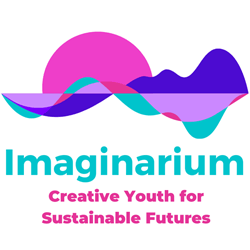During our Imaginarium project we asked youth workers from Ireland, Poland, Finland, France and Luxembourg what they needed to boost young people’s creativity. All of them agreed that young people absolutely have the ability to work creatively and that in general they don’t need a special methodology, complex methods or tools. What is essential however, is having the right space and atmosphere – safe, non-judgmental, open. External conditions are also important, not just for young people but for everyone.
Below, we share some of the valuable knowledge we learned with you:
Space
The size of the room should not overwhelm or crowd the amount of people participating. Too large a space overwhelms and too small could be a limitation to the participants emotional state. Furniture positioning should be flexible to allow participants to move around freely and adapt their setup to what best suits the task at hand. A relaxing space with couches can be an advantage, but only to a certain extent. Too many cushions and couches may lower the energy level too much to work, however on the flip side, too formal a setting may restrict the amount of creative thinking occurring. A space that has a clear focal point with a visual objective is a great option that encourages movement as well as communication.
Plants are also very easy on the eye and stimulate creativity. Being close to nature is one of the most effective imagination boosters out there, so when we conduct indoor creative sessions, we have at least a few plants inside.
Color
Some, but not all colors, are helpful. Take color theory into consideration when planning your material: Red increases your heart rate; yellow stimulates the intellect, and blue is often called the colour of the mind. To be very detail oriented, strong blues evoke clear thoughts and delicate blues help us stay focused and calm. If there is no color in the room you can always prepare motivating sentences, print them on coloured sheets and stick them to the walls.
Temperature
Surprisingly, the optimum temperature for creativity is about 20° Celsius. If people feel cold, it is better to warm them up with movement rather than heat the room. If people are warm, the best course of action is to open the window. This will also let you keep the air in the room from becoming too dry or humid.
Light
Daylight is best when working creatively as it helps balance serotonin levels in the body. Try to avoid direct sunlight – you shouldn’t have to squint. Light up pools of darkness (the corners for example) with reflective surfaces, even a light colored table or mirror works. If overhead daylight is not possible then a bright artificial light with a full spectrum or “daylight bulb” may help. Flexible lighting is definitely an advantage.
Sound
Acoustics in any given room should not be too harsh. Music is an option depending on the group dynamics and work purpose. For divergent thinking (when we want our imagination to run wild) music can be a great facilitator. The option with the most amount of research backing it is the classical genre and jazz: Bach, Mozart, Vivaldi.
However, when people need to focus and analyse the results of brainstorming for example, music can impair the process. It is advisable to ask the group what suits them best.
Seating
- Flexible seating
- Too many cushions and couches may bring the energy of the group to low
- Too much of a formal seating arrangement may evoke constrictive thinking
- Space that has a focal point with a visual clear objective
- Encourage movement, options that can change from space to space
- Invite people to the focal point in twos if it’s more comfortable
- Mix and match
Tools
- Use group tools to keep connection within the group
- Tools for small group becoming tools for large group
- Screens, paper and modeling clay
- Good opportunity for movement






